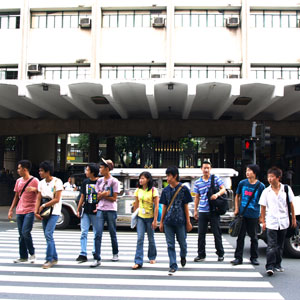When we send off our children to school, we are not just entrusting the school to provide a good education. We are also entrusting our child’s safety and well-being. A child—whether a toddler, a six-year-old, or an adolescent—becomes a school’s responsibility once he or she enters its premises. Therefore, providing a safe and secure environment for its students is a primary objective of any educational institution.
How Secure Should a School Be?
School security does not simply mean erecting walls around the school’s perimeter to keep out intruders. It also means ensuring the safety of students within the school premises and during school-sanctioned activities held outside the premises. It also includes protecting students not only from outsiders but from threats from fellow students.
According to Enrico de Guzman, president of the Campus Security Managers Association of the Philippines (CSMAP) and head of security of Lourdes School Mandaluyong, school security can be “considered the four walls of the school. It’s our responsibility to ensure the safety of the students. But we can extend our responsibilities even outside in instances wherein activities of the students are recognized activities of the school. Now you may ask, what if it is not an authorized activity or if it is already dismissal time? Well, whoever is the person in authority, he or she has the moral responsibility to attend to the emergency needs of the student.”
 CSMAP
CSMAP
The umbrella organization of campus security practitioners in the country is CSMAP, an organization established in 1994 that boasts of over 500 members to date. Explains de Guzman: “It is an organization of school security officers networking with each other and sharing best practices. It’s an inherited organization of our founder who is the former director for operations of International School, Mr. Aurelio Yalong.”
To become a member, one must complete a training course and become a Certified Campus Security Manager. The training spans three days, a Saturday, Sunday and another Saturday. But there is an option for a two-day course, in which case participants stay overnight.
“We do it on weekends so as not to disrupt the operation of the school due to the absence of the security manager,” de Guzman explains. “There are school administrators who get interested and who also train. We believe that school administrators are indirectly involved in school security. We follow the principle that security is everybody’s concern.”
The course is designed to train participants to be efficient security managers. “You will know the ins and outs of school security,” de Guzman says. Aside from attending classroom discussions, participants also do site surveys, usually in the school where the course is being held. They cap the training with a written test and oral defense.
The training has generated positive feedback from participants. “Would you believe,” de Guzman narrates, “there was one time a retired general tried to test us in our training? They owned a school, and he called me up. He said he wanted to take the training and he would also like to bring his son. They both completed the course and were very pleased.”
De Guzman took over the CSMAP presidency in 1999. He says one of his main goals is to offer the CCSM certification course more often. “Sa ngayon, we’re lucky if we can hold the course twice a year.”
Outside the School
Security of students should not necessarily be limited to the confines of school premises. The immediate vicinity of the school, while technically already out of the school’s jurisdiction, is also an area of concern.
Consider this case of two brothers, both second-year high school students in a private school in Quezon City. One day after class, they were standing outside the school gate looking for their school service. A man approached the two and told them their regular service was unavailable and that they were the substitutes. The brothers were led to a waiting van, where the elder brother immediately sensed something was amiss. They were the only ones in the van and he noticed that the driver was taking a different route home. When he brought out his cell phone to call his parents, one of the men grabbed it from him. The two were subsequently divested of their other belongings before being dropped off in a remote area in Fairview. Thankfully, they were not physically harmed.
The two brothers eventually found their way to a convenience store, where they sought refuge, crying and not knowing what to do.
“Luckily, a friend of their mother’s saw them and asked them what they were doing all the way in Fairview,” narrates an uncle of the victims who requested anonymity both for himself and his nephews. “If it weren’t for my sister’s friend, who knows how long they would have stayed at the convenience store not knowing what to do.”
The uncle adds that both boys were traumatized by the incident and refused to go to school for several days.
This incident, according to de Guzman, is a clear illustration that schools can only do so much when it comes to securing the safety of its students, and parents also have to do their share.
“Unfortunately, no matter how hard we try our best to give ample protection to our students, sa kahit saang eskuwelahan, things like that happen,” he notes. “Outside the school there are still illegal buses operating. They have no control over that. And these things happen.”
De Guzman also stresses that while the school is not liable for what happened to the two boys, this should not pose a limit to what the school can and cannot do for its students outside its boundaries.
“No, the school is not liable,” he says.” I don’t think there was a lapse in procedure there because at the beginning of the school year orientations are already being made and parents should also figure out ways to protect their own children after dismissal. Because in principle the responsibility of the school ends once the students are already out of the campus. But once a school authority is present, and he sees the need to assist the student, it is his moral obligation—but not his legal obligation. Kasi yung iba, ayaw na nilang makialam pag nasa labas na. But they should think, these are your students and you should still protect them kahit na dismissal na.”
While school services are generally safe, de Guzman points out that ensuring total safety for students who are brought home in school services is not easy: “Different schools have different ways of treating the school buses. It is fortunate if the school has enough parking space for school buses, but many schools have their school buses dropping off the students just outside the campus but near the gates.”
“But as campus security practitioners, we prefer that the students be dropped off by the school bus inside the school campus or in a designated area wherein it is really very safe, preferably nearest to the gate but far from the streets where vehicles come and go,” de Guzman says.
 “In the case of our school, Lourdes School, we have a separate area for the school buses and the parking area is right inside the campus. If you recall what MMDA chairman Bayani Fernando said, that there are so many schools with big football fields which he suggested can be used as a parking area for school buses, many just laughed it off. But I took that seriously because we have a big football field which can accommodate up to 50 school buses,” according to de Guzman.
“In the case of our school, Lourdes School, we have a separate area for the school buses and the parking area is right inside the campus. If you recall what MMDA chairman Bayani Fernando said, that there are so many schools with big football fields which he suggested can be used as a parking area for school buses, many just laughed it off. But I took that seriously because we have a big football field which can accommodate up to 50 school buses,” according to de Guzman.
De Guzman says school bus operators undergo thorough scrutiny. “We check on the papers, we check on the backgrounds of the drivers and we make sure that all the school buses entering our parking area are legally operating. We require them to submit papers. And we give them stickers.”
Current Security Practices
Basic security practices are generally the same across schools: students must wear their identifications cards (IDs) at all times, visitors must register at the gate, vehicles must have the proper stickers in order to enter the campus.
A unique security situation, though, exists at the University of the Philippines’ Diliman campus, where the security force must secure a massive 493 hectares made up of not only academic buildings, but residential areas as well.
Exacerbating the problem, according to UP Diliman Vice Chancellor for Community Affairs Grace Gregorio, is the decline in the number of members of the UP Diliman Police Force.
“Through the years, the number of UP Diliman Police personnel has decreased significantly, and to date there are about 60 UPDP personnel or maybe less,” she explains. “There are about 57 right now. And I believe there is even less assigned to UPDP because some of them were assigned to different security units like the task force on squatting communities. Before there were about 200.”
Because some of its roads are used as alternate routes to and from Katipunan and Philcoa, UP has long been open to the public, and screening of vehicles that pass through is close to impossible. It is only fairly recently, though, that this openness has led to serious security problems.
“Mahirap na ang buhay,” Gregorio says. “Before people would respect the sanctity of the university. Now, they’re quite bold in entering the campus and committing a crime.”
The UPDP does not necessarily secure the academic areas of the university. Rather, says Gregorio, they are more focused on “the other portions of the university especially those outside the academic core. Primarily what they are securing would be UP property that are unused and are prone to illegal settlers coming in.”
Gregorio continues: “Meanwhile, in the core of the university, we have another security team called the Special Security Brigade. They function like barangay tanods, and they’re tasked to do foot patrol around the academic oval and in the residential areas within the academic core like Areas 1-3, Hardin ng Rosas, and the Shopping Center. There are about 68 of them. They operate in a buddy system primarily to provide security around the academic oval where the student population is concentrated and to serve as a deterrent.”
Gregorio adds that while UP does not impose any curfew, by 10 o’clock there shouldn’t be any activity around the academic oval that is not sanctioned by the university.
In both Lourdes School and UP Diliman, the most common crime reported is theft, although for different reasons.
“The most rampant would be theft, mostly in residential areas,” Gregorio explains. “We classified the different types of crimes that are committed on campus. Definitely, mas mataas ang crimes committed by outsiders. This I attribute to the very porous nature of UP Diliman. The absence of a perimeter fence, the freedom that people enjoy in coming to the university. We have crimes in the academic buildings and mostly these would also be theft.”
Gregorio stresses, though, that over a 10-year period, there has actually been a decrease in the number of crimes on campus. She attributes this to the SSB and the new ID policy.
“One new requirement is that UP students should wear their ID at all times so that they are easily identifiable from outsiders. In the past we established that most of the crimes committed in the academic buildings were committed by outsiders.”
De Guzman, on the other hand, explains that the Lourdes security force’s main objective is not crime prevention, even though incidents of theft do occur on campus.
“Our primary concern here is prevention of injury,” he says.” I cannot promise that it can be prevented, although that’s one concern that we always look out for. The number one theft in schools is theft of cell phones. But with the style of guarding that we are doing, at least na-minimize iyan. But I cannot boast of 100%. Kasi mayroon akong naka-assign na roving guard round the clock.
“We have two doors per classroom, but I had them installed with a peep window. So halimbawa naka-break ang mga students, the roving guard can use the peep window to check on the belongings of the students. So anybody seen inside the classroom who is acting suspiciously can be questioned especially if he is supposed to be in one area and he is in another area.”
De Guzman does not subscribe to any ideal ratio of students to security, although he says in Lourdes School 3,000 students are watched over by eight guards. “I have six guards in one area, and one guard at the school buses, and one roving.”
He also stresses the need for a school to implement a consistent security policy. “We have guidelines for visitors. Then we have guidelines for the students for securing their own things, staying inside the classroom. If it’s time for them to be outside the classroom, all of them should be out of the classroom.”
De Guzman explains: “They are not to bring things which are not needed. If ever they bring valuable things inside the campus, it is their responsibility. Cell phones are not totally prohibited, but they are responsible for their cell phones. In the elementary department, it’s prohibited, but in high school, there’s regulated use of the cell phone. They have to take care of their cell phone. They can only use cell phones before and after classes.”
De Guzman also points out that while security measures are important, it is equally important to have some degree of flexibility. After all, these are just kids they’re dealing with.
“Even the ‘No ID, no entry’ rule is frowned upon by many schools because of the loco parentis principle and the right of everyone to an education. We do not recommend the practice of ‘No ID, no entry’ in school campuses. However, there are schools where the student really cannot enter if he does not have his ID.”
In UP’s case, Gregorio says, if a student misplaces his ID, he can get a certificate from his college. With the drop in theft cases in academic buildings attributable to the ID rule, UP will continue to strictly implement it with no exceptions.
But while de Guzman can be a little lenient with students, he is super-strict about their visitor policy. “We have the prerogative to restrict the entry of individuals in our campus if we feel they should not be in our campus. If they have to be in our campus, they have to fill up forms.”
In UP, visitors wishing to enter academic buildings are questioned by the guard, but are not required to leave their ID.
Firearms
De Guzman says gun-less security in campuses is an ideal scenario, and is usually observed in all-girl sectarian schools. But not all schools subscribe to it. In the case of Lourdes School, he allows only one guard, the one positioned outside, to bear a firearm.
“What I do is yung mga critical areas lang ang may baril. But ang mga roving guards, walang mga baril. Even sticks wala. The reason guns are not banned 100%, halimbawa sa labas, sa parking area, very critical ang area na iyan. Open iyan eh. Papaano kung sa parking area maganap ang attempted kidnapping of our student? What defense can we give? Sigurado, aangal ang mga magulang ng maki-kidnap diyan. Guwardiya ka, wala ka man lamang pang-depensa. Pero laging may precautions ang mga baril. Hindi nakakasa.”
At the end of the day, though, vigilance from all parties involved is the key. “Like I said, school security is everyone’s concern. A school’s security staff can only draw up and implement security measures, but the student as well as his parents must be alert at all times.”
After all, these are kids we’re talking about. •


 CSMAP
CSMAP



